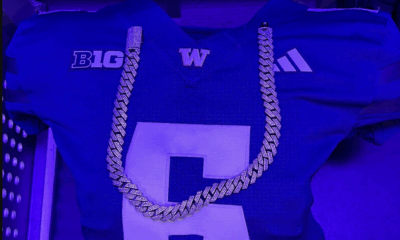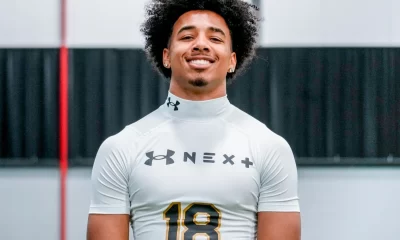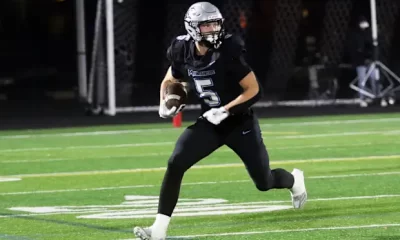Jimmy Lake’s voice echoes around an empty Husky Stadium during practice: “score or get the ball back!” In Lake’s mind, there is nothing better than hearing a cacophony of cheers erupting from a packed Husky Stadium after a turnover caused by his vaunted Death Row Defense.
Whether a defensive back jumping a route to intercept the ball, an edge rusher getting a strip sack and fumble recovery, or a linebacker getting a scoop and score…somehow, some way, someone on his reloaded defense must get the Washington offense extra opportunities. Or, even better, punch the ball into the endzone on their own.
Regardless of how many defenders Washington’s famed “Death Row Dawgs” defense has put onto NFL rosters, the Huskies have produced the number one scoring defense in the Pac 12 Conference for the past four years and one of the top defensive units in the country.
Now, with a roster full of hungry young dawgs, Coach Chris Petersen must find the right mix of skills, talents, schemes and formations to unleash upon an unsuspecting Pac 12. While it might seem to be the “same ol’ same ol’” from the outside of the locker room, every season the defensive alignments and game plans change according to the skill-sets and abilities of the defensive roster.
In 2016, the defensive line was experienced and tough against the run, but in 2018 they personified a “bend but don’t break” philosophy. From 2015 to 2018, many NFL caliber defensive stalwarts have come and gone, but at the end of every season, purple still reigns in the defensive standings.
Rewind to an unforgettable Friday night in the fall of 2016, Stanford’s offense was in utter disarray. Who can forget Stanford’s linemen cupping their hands over their ears trying to hear the play-call? Cardinal heads were spinning from the relentless noise of a raucous Husky stadium crowd fueled by a dominant defensive performance that was reminiscent of the 1991 National Championship team being honored during halftime.
It was like the good old days on Montlake. That night, led by Psalm Wooching and Joe Mathis, who combined for 5 sacks, Husky Stadium never seemed to take a seat, ending the game by storming the field.
Last season, All-American tackling machine linebacker Ben Burr-Kirven led a Husky Defense that kept everything in front of them. In fact, no one was better at limiting explosive plays in 2018 than the Washington Huskies. While leading the Pac 12 in scoring defense again, it was clear that the defense was missing the kind of pressure on the quarterback that produces turnovers and shorter drives.
As a team, in 2018, UW finished 84th in the country with 24 sacks, lacking an elite edge rusher. While the final results were acceptable, most rabid Huskies feel like the 2018 defense left some meat on the bone.
Entering the 2019 campaign, the reigning Pac12 Champs will have a different cast of characters, a new look and a fresh swagger. There are reasons to believe that the defense has several areas where it can continue to improve. According to Pick 6 Previews the Washington defense lost roughly 66% of their productivity. That figure puts them near the bottom in the country for that metric. Gone is the nation’s leading tackler, Ben Burr-Kirven, Taylor Rapp, Byron Murphy, Jordan Miller, JoJo McIntosh and Greg Gaines to name a few.
But don’t expect Coach Pete to blink because he’s been down this path before…many times; and he is continually adapting the defense to the strengths of the players. Year after year CP finds himself replacing a ton of talent while maintaining a high level of play. Even though the 2018 defense brought the Huskies another Pac 12 Championship and a Rose Bowl berth, there is still room to grow and improve.
5 Ways Washington’s Defense Can Improve in 2019
[icon name=”angle-right” class=”” unprefixed_class=””] Create More Turnovers
Getting extra possessions for the offense is Job 1 for Washington’s Defense. Or, as Defensive Coordinator Jimmy Lake preaches to his young disciples, “Score or get the ball back.”
In 2016, linebacker Keishawn Bierria led the country in fumble recoveries. Not surprisingly, the Huskies boasted one of the top turnover margins in college football at +1.2 per game. In 2018 however, UW’s turnover margin dropped dramatically to only +0.3, the result of 8 fewer interceptions, 5 fewer fumble recoveries and 16 fewer sacks than the 2016 campaign.
Will the 2019 edition of the Death Row Dawgs be able to produce more turnovers? The answer to that question will depend heavily upon a talented, but unproven linebacker crew led by Senior Brandon Wellington. Wellington will be counted on to diagnose the opposing offense and get his younger teammates in position to fly to the ball with reckless abandon. If Wellington can implement the lessons he has learned from his predecessors- BBK, Bierria and Azeem Victor, this defense could regain its turnover advantage.
[icon name=”angle-right” class=”” unprefixed_class=””] Improve Edge Rush
According to former Husky Sack Master Jason Chorak, when a defense can consistently apply pressure on the opposing quarterback, the sacks and the hits begin to take a physical and mental toll. “Most interceptions are when the QB gets hit and doesn’t have enough juice on the ball,” the Husky Legend said. “Or, he gets hit and throws up the ball in a different area because he cannot follow through on his throwing motion.”
For Husky fans, nothing gets a crowd more jacked up than watching a sea of purple crash through an offensive line and put a quarterback on his backside. In 2018, the Huskies were often close to the quarterback, but failed to register many sacks.
In spite of the loss of Greg Gaines, BBK, Tevis Bartlett, and others there are a few reasons to believe the Huskies will regain their defensive pressure and ultimately get sacks this season.
It starts with Outside Linebacker, Joe Tryon. He is a raw, but gifted physical specimen who began to come into his own as the 2019 season wore on. At 6’5” and 262lbs, Tryon possesses the tools and the demeanor to pose a real problem for opposing offenses. Tryon is hungry too, stating this off-season that he was making it his personal mission to put pressure on the signal callers in 2019.
One of his partners in crime, Ariel Ngata, showed promise early in 2018. In fact, the speedster was beginning to wreak havoc as an edge rusher from his Outside Linebacker position before being injured 4 games into the season. But the light was on and shining brightly as Ngata was the defensive star of Spring Football. Many observers believe Ngata is primed for a breakout season in 2019.
While some critics may have viewed Ryan Bowman’s last season as a “sophomore slump”, Pro Football Focus is high on Bowman’s pass-rush efficiency. “Ryan Bowman is 7th in the country among returning edge rushers,” PFF’s Cam Mellor told Real Dawgs’ Mike Martin. “He had a 20% pass rush win rate in 2018.”
Another wrinkle that could impact the edge rush is the decision to move Senior Benning Potoa’e from Outside Linebacker to the interior defensive line. While Potoa’e was excellent at sealing the edge, he lacked the quick twitch necessary to get to the quarterback. After gaining 20lbs this offseason, Potoa’e now at 6’3”, 290lbs is in his ideal position as an interior lineman. With Bowman, Tryon and Ngata tearing around the edge and inside defensive lineman Potoa’e and Levi Onwuzurike crashing up the middle, there is more than enough size, speed and ferocity to collapse the pocket and bring down the quarterback.
[icon name=”angle-right” class=”” unprefixed_class=””] Defend More Passes
Astonishingly, 64% of passes were completed against the Washington D in 2018. Where the DBs excelled was in being what Pro Football Focus calls “Sticky” in coverage. Translation- Force short passes and do not give up the home run ball.
Some fans may call it, “dink and dunk” football. Some call it merely an extension of the running game.
As the season wore on, it became clear that Coach Pete believed this bend but don’t break philosophy was the best approach to reduce scoring. In Petersen’s mind, erasing explosive plays and forcing teams to work their way down the field in 2 and 3 yard increments posed a difficult challenge for most of their opponents.
This philosophy is evidenced in these similarly contradictory statistics- The Huskies finished first in the nation at limiting explosive passing plays despite allowing a gaudy 64% completion percentage. According to Brett Ciancia of Pick Six Previews Washington allowed an explosive passing play just 3% of the time.
Losing four defensive backs to the NFL does not seem like a successful recipe for improving a pass defense. However, when the guys stepping into their roles are rangy “long levered” DB’s like 6′-3″ Keith Taylor and 6′-2″ Dominique Hampton, 6′-1″ Julius Irvin, and uber athlete Kyler Gordon, it is easy to believe that this year’s squad may see an uptick in pass break-ups and interceptions.
In fact, an increased emphasis on length and size along the line and in the secondary will likely result in more balls batted down at the line of scrimmage as well as tighter throwing windows for opposing quarterbacks. Paired with increased pressure on the QB, there will be less time and less space for the quarterback to find the safe outlet passes that became commonplace last season.
[icon name=”angle-right” class=”” unprefixed_class=””] Create More Negative Plays
By design, the 2018 Washington defense generally avoided rolling the dice on blitz packages, opting to apply pressure with sound defensive packages and elite deep coverage. While the numbers point to the success of this philosophy, there were times when a negative play would have done both the offense and the defense a world of good.
Washington dropped from 16th in the country with 38 sacks in 2017 to 84th nationally with 24 sacks in 2018. Pick 6 Previews said that Washington finished the year 110th in the FBS in tackles for loss.
One not so secret weapon the Huskies may choose to deploy more regularly in 2019 is the versatile mighty mite Myles Bryant. Bryant, who has been utilized as a corner, safety and nickel back has proven to be an adept pass rusher and run stuffer off of the edge. Like his mentor, Budda Baker, Bryant may be called upon to keep offensive coordinators up all night trying to figure out where Lake might choose to send number 5 knifing through the line.
[icon name=”angle-right” class=”” unprefixed_class=””] Return to Husky Fever
Seattle, the home of the 12’s, knows how to change a game by the implementation of deafening decibels. In fact, the University of Washington is on record for having the loudest stadium in college football history with a whopping 133.2db in the 1992 Nebraska game.
In that game, UW Coach Don James pinned the Cornhuskers deep inside the 3 yard line. That’s when the Husky Stadium crowd took over. The booming crowd caused a false start, a delay of game, and a timeout. With the tail of the ball perched just inches from the goal line, UW’s Tommy Smith came in from Nebraska’s QB’s blind side and buried him for a safety producing the roar that is still the record holder today.
Former James assistant, Skip Hall, remembers the cauldron of terror that opposing offenses faced in Husky Stadium. “We would say ‘the roar prevents the score'”, he remembered.
That day in 1992 the roar helped them score… AND get the ball back. If Washington can recapture that level of Husky Fever that once made Seattle a college football town, there is no doubt the fans could contribute to an improved Husky defense in 2019.
If this iteration of the Death Row Dawgs can disguise their blitz packages, hide where their pressure will come from in partnership with a boisterous Husky Stadium, UW will once again force visiting offenses to delay snaps, interrupt their cadences, false start, and call panic stricken timeouts. This creates a cyclical effect as the crowd senses a feeding frenzy, the defense gets more hyped and as the defense gets more hyped, the louder the stadium becomes.
It may not be fair to expect the defense to match the historic squads like the 1984 “Purple Reign” or the 1991 “Purple Haze” defenses, there are certainly areas where, the 2019 iteration of Death Row Dawgs can improve while staying true to themselves. The pieces to the puzzle are there for UW’s defense to remain elite and even take a few steps forward. “Score or get the ball back…” that’s all Jimmy Lake is asking for.
— Mike Martin
With Warren Mainard (editing) and Emily Tomczak (graphic)










